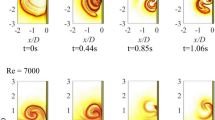Abstract
Vortex pairs are studied using a dye tracing visualisation technique and a particle tracking velocimetry system. The vortex pairs are produced by gravity induced inlets of water issued through a uniform gap. The inlet Reynolds number is Re=Ud/ν≈875 in all tests (d being the gap width and U the cross sectional mean velocity), i.e. the flow is in the laminar regime. Initially, the dipolar vortex structure is two-dimensional, but after travelling a distance of a few times its own width, the flow structure becomes unstable, breaks up and changes into a three-dimensional flow structure. The breakup appears to be caused by an axial flow in the core centres of each vortex of the dipolar structure. These axial flows are induced by boundary effects related to the von Karman viscous pump. After the breakup, it is believed that a vortex ring is formed through reconnection of rudiments from the dipolar structure mediated by the wall induced vorticity.
Similar content being viewed by others
Author information
Authors and Affiliations
Additional information
Received: 20 November 1995/Accepted: 14 November 1996
Rights and permissions
About this article
Cite this article
Laursen, T., Rasmussen, J., Stenum, B. et al. Formation of a 2D vortex pair and its 3D breakup: an experimental study. Experiments in Fluids 23, 29–37 (1997). https://doi.org/10.1007/s003480050083
Issue Date:
DOI: https://doi.org/10.1007/s003480050083



